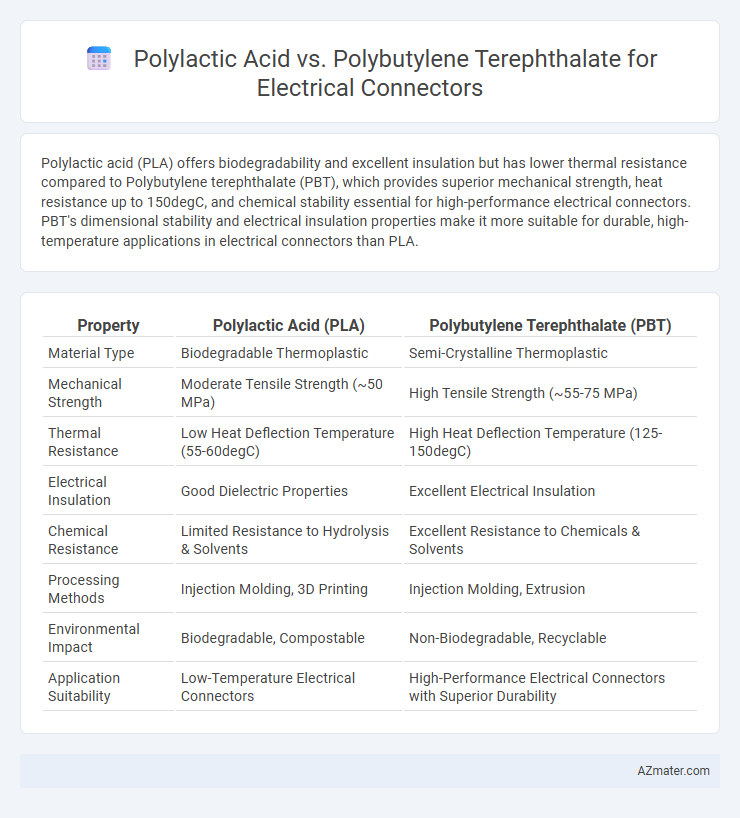Polylactic acid (PLA) offers biodegradability and excellent insulation but has lower thermal resistance compared to Polybutylene terephthalate (PBT), which provides superior mechanical strength, heat resistance up to 150degC, and chemical stability essential for high-performance electrical connectors. PBT's dimensional stability and electrical insulation properties make it more suitable for durable, high-temperature applications in electrical connectors than PLA.
Table of Comparison
| Property | Polylactic Acid (PLA) | Polybutylene Terephthalate (PBT) |
|---|---|---|
| Material Type | Biodegradable Thermoplastic | Semi-Crystalline Thermoplastic |
| Mechanical Strength | Moderate Tensile Strength (~50 MPa) | High Tensile Strength (~55-75 MPa) |
| Thermal Resistance | Low Heat Deflection Temperature (55-60degC) | High Heat Deflection Temperature (125-150degC) |
| Electrical Insulation | Good Dielectric Properties | Excellent Electrical Insulation |
| Chemical Resistance | Limited Resistance to Hydrolysis & Solvents | Excellent Resistance to Chemicals & Solvents |
| Processing Methods | Injection Molding, 3D Printing | Injection Molding, Extrusion |
| Environmental Impact | Biodegradable, Compostable | Non-Biodegradable, Recyclable |
| Application Suitability | Low-Temperature Electrical Connectors | High-Performance Electrical Connectors with Superior Durability |
Introduction to Electrical Connectors and Material Selection
Electrical connectors require materials with excellent mechanical strength, thermal stability, and electrical insulation properties to ensure reliable performance in diverse applications. Polylactic acid (PLA) offers biodegradability and ease of processing but has limited thermal resistance and mechanical durability compared to Polybutylene terephthalate (PBT), which provides superior heat resistance, chemical stability, and dielectric strength. Material selection for electrical connectors prioritizes long-term reliability, making PBT a more suitable choice in high-performance and demanding environments.
Overview of Polylactic Acid (PLA)
Polylactic Acid (PLA) is a biodegradable thermoplastic derived from renewable resources such as corn starch or sugarcane, widely used in electrical connectors for its excellent insulating properties and ease of molding. PLA offers high tensile strength, low shrinkage, and good dimensional stability, making it suitable for precision components in electronics. Compared to Polybutylene Terephthalate (PBT), PLA provides an eco-friendly alternative with comparable electrical insulation but lower thermal resistance and impact strength.
Overview of Polybutylene Terephthalate (PBT)
Polybutylene terephthalate (PBT) is a highly durable thermoplastic polymer widely used in electrical connectors due to its excellent electrical insulation properties, mechanical strength, and resistance to heat and chemicals. Compared to polylactic acid (PLA), PBT offers superior thermal stability with a melting point of around 225degC, making it suitable for high-temperature applications. Its low moisture absorption and dimensional stability ensure reliable performance and longevity in demanding electrical environments.
Mechanical Properties: PLA vs PBT
Polybutylene terephthalate (PBT) exhibits superior mechanical properties compared to polylactic acid (PLA) for electrical connectors, including higher impact resistance and greater tensile strength, ensuring durability under mechanical stress. PBT also offers enhanced heat resistance and dimensional stability, which improves performance in variable temperature environments common in electrical applications. Conversely, PLA, while biodegradable and eco-friendly, has lower toughness and thermal resistance, limiting its suitability for demanding mechanical conditions in electrical connectors.
Thermal Stability Comparison
Polylactic acid (PLA) exhibits lower thermal stability with a maximum operating temperature around 60-65degC, which limits its use in high-temperature electrical connector applications. Polybutylene terephthalate (PBT) offers superior thermal resistance, sustaining continuous use at temperatures up to 120-150degC, making it ideal for connectors exposed to heat and electrical stress. PBT's enhanced thermal dimensional stability and resistance to deformation under temperature fluctuations ensure greater reliability in demanding electrical environments compared to PLA.
Electrical Insulation Capabilities
Polylactic acid (PLA) offers moderate electrical insulation properties suitable for low-voltage electrical connectors but exhibits lower heat resistance compared to Polybutylene terephthalate (PBT). PBT demonstrates superior dielectric strength, thermal stability, and moisture resistance, making it ideal for high-performance electrical insulation in connectors subjected to demanding environments. The enhanced electrical insulation capabilities of PBT contribute to improved safety and longevity in electrical connector applications.
Chemical Resistance: Suitability in Electrical Applications
Polylactic acid (PLA) offers limited chemical resistance, making it less suitable for electrical connectors exposed to harsh solvents or high humidity, while polybutylene terephthalate (PBT) excels with superior resistance to acids, alkalis, and lubricants, ensuring durability in demanding electrical environments. PBT's high thermal stability and resistance to hydrolysis further enhance its performance stability under electrical operational stresses. The robust chemical resistance profile of PBT makes it the preferred material for electrical connectors requiring long-term reliability and safety.
Environmental Impact and Sustainability
Polylactic acid (PLA) offers significant environmental advantages for electrical connectors due to its biodegradability and derivation from renewable resources such as corn starch, reducing reliance on fossil fuels and lowering carbon emissions during production compared to polybutylene terephthalate (PBT). PBT, while durable and heat-resistant, is a petroleum-based thermoplastic that presents challenges in recycling and contributes to long-term plastic pollution due to its slower degradation rate in natural environments. Choosing PLA supports sustainability goals by enabling easier composting and reducing ecological footprints, although considerations for thermal and mechanical performance must align with application requirements.
Cost Efficiency and Manufacturing Considerations
Polylactic acid (PLA) offers cost efficiency through its renewable bio-based sourcing and lower material expenses but presents challenges in thermal stability and durability compared to polybutylene terephthalate (PBT). PBT provides superior mechanical strength, chemical resistance, and higher heat deflection temperature, making it more suitable for electrical connectors in demanding environments despite its higher raw material and processing costs. Manufacturing considerations favor PBT for injection molding processes due to its dimensional stability and faster cycle times, whereas PLA may require modified processing parameters to prevent brittleness and ensure performance consistency.
Application Suitability and Industry Recommendations
Polylactic acid (PLA) offers biodegradability and good insulating properties, making it suitable for low-stress electrical connectors in eco-friendly consumer electronics, but it has limited thermal resistance around 60degC. Polybutylene terephthalate (PBT) excels in high-temperature stability up to 150degC, chemical resistance, and dimensional stability, fitting industrial and automotive electrical connectors requiring durability and performance under harsh conditions. Industry recommendations favor PBT for connectors exposed to elevated temperatures and mechanical stress, while PLA is preferred for environmentally conscious applications with moderate electrical and thermal demands.

Infographic: Polylactic acid vs Polybutylene terephthalate for Electrical Connector
 azmater.com
azmater.com